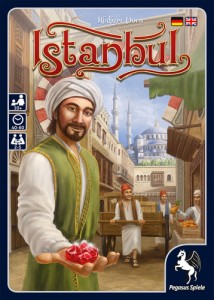 The “Spiel des Jahres” is a yearly award presented in Germany to a board or card game that exemplifies excellence in game design. The main award is the Spiel des Jahres (“Game of the Year”) itself, and this year, that award went to a game called Camel Up.
The “Spiel des Jahres” is a yearly award presented in Germany to a board or card game that exemplifies excellence in game design. The main award is the Spiel des Jahres (“Game of the Year”) itself, and this year, that award went to a game called Camel Up.
In recent years however, probably due to the wealth of quality games being published, the jury committee created a secondary award, called the “Kennerspiel des Jahres”, or “Connoisseur Game of the Year”. This award is usually reserved for more complex, or “gamers” games. In 2014, that award went to a game called Istanbul.
I’m going to spoil the suspense right now by saying that I really love this game, and its award was well-deserved. If you haven’t played Istanbul yet, get yourself a copy and be prepared to be whisked away to a frantic bazaar area where merchants are scrambling to acquire more gems than their competitors, to position themselves as the most successful trader at the bazaar.
Istanbul is a pick-up-and-deliver type game, designed by Rüdiger Dorn. It plays 2 to 5 players and takes about 40-60 minutes to play. Istanbul plays best with 3 players.
Game Overview:
In Istanbul, players are merchants, leading themselves and 4 assistants throughout the various locations in the bazaar. Each location has a different specific action that can be taken on it. The “catch” in the game, however, is that in order for a merchant to be able to take the action on a space, he needs to either leave behind one of his assistants at that space, or have an assistant already at that space, ready to be picked up again. It is crucial to plan ahead with movements so that a merchant doesn’t get left by himself on a space. If that happens, the player won’t be able to take the action of that space. The ultimate goal of the players is to collect a certain number of ruby gems. This can be accomplished in several ways, which are described in more detail below.
Game Components:

Istanbul is chock-full of components, starting with the 16 bazaar location tiles, which are laid out on the table in a 4 x 4 grid. Players can use the suggested “starter” layout, an “advanced” layout that makes the game more difficult, or can even arrange the tiles randomly. Several of the tiles have components placed on them. Some of them will receive gems (the game-winning component), while others will be stocked with “Mosque” tiles, “market” tiles, or cube counters for the Post Office location.
Each player has a good assortment of components as well, the most important of which is a stack of colored discs, representing his merchant (which is stickered to identify him) and assistants (blank discs). These merchant/assistant stacks are placed on the Fountain space to start the game. One additional figure in each player color, a taller disc called a “family member”, is placed on the Police Station space.
Each player also receives a wheelbarrow tile, which is used to keep track of his supply of goods. Four cube counters in a player’s color are placed in the “0” space of each goods row (blue: jewelry, red: fabric, green: spices and yellow: fruit). The wheelbarrow has “holes” in it to represent where extension pieces can be added, in order to increase the wheelbarrow’s capacity. Players also get a starting supply of money (Lira in this game), and one bonus card each. Lastly, there are two dice that are used at a few of the bazaar sites, and two tall wooden pieces, called the “Governor” and the “Smuggler”, which are placed on random sites of the bazaar.
How to Play:
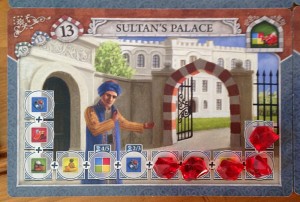
On a player’s turn, two phases will usually be performed: movement and action. There are also some additional phases that may be played in certain situations. In the movement phase of a turn, a player moves his merchant (and any assistants under him) either 1 or 2 spaces orthogonally, without backtracking to the space he started his turn on. If the space the movement ends on does not already contain an assistant in the player’s color, he will “drop off” an assistant on that space, by removing one disc from the stack and placing it next to the merchant stack.
If the ending space already DOES contain a player’s assistant (from a previous turn), the merchant stack gets placed on top of that assistant, so the assistant is “picked up” in effect. In either case, after the movement phase, the player will then get to take the action on that space. If a player happens to end his merchant’s movement without an assistant present, the player cannot take the action on the space.
Depending on the space that the merchant ends his movement on, there are several actions that can be taken.
• Warehouses (Fabric, Fruit, or Spice): the player can max out his supply of a particular type of good.
• Wainwright: The player can purchase a wheelbarrow extension for 7 Lira, and once he has added 3 extensions, he may collect one of the gems there and add it to his wheelbarrow.
• Post Office: This space offers an ever-changing assortment of goods and money for the player to receive.
• Black Market: Gain a choice of goods, as well as possibly gaining a (harder to obtain) blue “jewelry” good with a lucky dice roll.
• Tea House: A player can earn money by matching or beating a called-out number with a dice roll.
• Markets (Small and Large): A player can sell various combinations of goods for money.
• Mosques (Small and Great): Offer tiles for purchase that give a player a rule-breaking ability once per turn.
• Caravansery: Holds all of the bonus cards discarded during the game.
• Police Station: The player “frees” his family member (if there), by moving that piece to any space in the bazaar, and can then take the action on that space immediately.
• Sultan’s Palace: Offers gems in trade for certain combinations of goods
• Gemstone Dealer: Where the player can purchase gems outright with money.
• Fountain: A player can return all of his assistant discs to his merchant stack.
The game continues with players taking turns in order, until one player has gained 5 (or 6) gems. The round is played to completion, and the player with the most gems wins. Ties are broken by most leftover Lira, most leftover goods in their wheelbarrow, and most leftover bonus cards, in that order.

Game Experience:
In the short time I have owned Istanbul; I have played it several times with all player counts. I think that 3 players seem to be the optimal number since there is just enough interaction going on. Playing with 2 and 4 players is pretty good as well. I must admit, however, that I didn’t enjoy my 5-player games quite as much. The playing field is too crowded (literally) with that number and things can get pretty chaotic. Since this is a race game at heart, it just becomes a little too difficult to plan any sort of strategy, since there will almost always be another player in the wrong place at the wrong time to foil your plans. Some players enjoy this style of play more than others; I can take it or leave it.

Having said that, this is one of the most enjoyable games I have played in the past year. I have taught it to many players in my family, and in my gaming groups, and I have yet to encounter anyone who did not have a good time with it. The sheer number of different actions available to you throughout the game is the main highlight for me, and yet it’s still an easy game to teach and understand. I also really like the movement mechanic, I think it’s a very clever aspect of the game and after doing a little research, I discovered that the designer actually used this same mechanic in an earlier game of his, Genoa.
In that game, there was one “tower” of game discs that was moved around the board by all players, dropping off discs as it went. Obviously, he expanded that concept here by giving each player their own stack that changed size throughout the game. In my mind, this is just such an elegant mechanic that even works thematically. After a few plays, it started to become clear to me that movement efficiency is critical to success. Most new players will leave a trail of assistants scattered over the board and then will regularly make trips back to the Fountain to collect them all. This is pretty much a waste of a turn where you could be taking an action, so I like to try and avoid too many Fountain visits during the game.
Players sometimes forget that they can take an action by picking up an assistant, in addition to dropping one off, so if possible, I like to try and set up an efficient path so I am almost always either dropping off or picking up an assistant, in order to keep taking actions.
Obviously, though, you’re not playing the game in a vacuum, and it’s quite possible that once other players figure out your path strategies, they will most do whatever they can to mess with them. For example, there’s nothing more satisfying than knowing that a player wants to go to the Wainwright and has just enough money to buy an extension, and then beating him to that space, so he’ll have to pay you by landing there, possibly leaving him with not enough money left to buy the extension. Another example is by beating a player to one of the Mosque spaces and taking a tile from there that he had his heart set on. In so many instances during play, this is truly a race game.
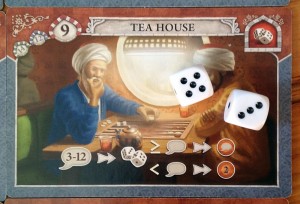
I’m always in favor of a game that presents a player with multiple paths to victory, and Istanbul shines in that aspect as well. You can try to acquire 3 wheelbarrow extensions and the Mosque tiles as a way to earn your gems. If you don’t want to do that, try amassing a fortune in money and visit the Gemstone Dealer a little more often. Or, why not concentrate on building up your goods supply to gain multiple gems from the Sultan’s Palace? All of these strategies can be successful. The powers and abilities of the Mosque tiles and the bonus cards, in addition to the spaces that use dice rolls, add even more excitement to an already enjoyable game.
Speaking of dice rolls, there are the hardcore strategic gamers out there who seem to dismiss anything having to do with the luck or randomness of dice. However, I think it works fine here and it adds another thematic element to the game. If you’re going to be in a gambling house or dealing with less-than-savory “black market” types in some faraway marketplace, you can be sure that luck will play a big factor in those dealings. The luck is not a central part of the game by any means, and if a player is really against the luck factor, they can just avoid those spaces during the game, without sacrificing any possible paths to winning. It just so happens that in my gaming groups, the Tea House gambling site was usually pretty popular.
Final Thoughts:
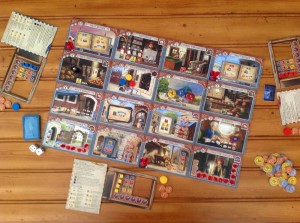
They say that variety is the spice of life, and that saying is very appropriate in a game with so much variety in it (and even has a location for trading spices!). Some of the variety in Istanbul has already been noted above, but I haven’t even yet mentioned the variety provided by the variable bazaar tile setups. The “starter” layout is perfectly suited for new players by optimizing the resource-to-cost paths. In contrast, the “advanced” layout really forces players to think about how to move around the bazaar, since every site always seems to be far away when you need to get to it.
When you add in the variability created by using random tile layouts, the replay ability factor of this game goes through the roof. In closing, I’ll simply repeat what I revealed at the beginning of this review: I simply love this game. It’s widely available now, so treat yourself to a fun gaming experience with Istanbul!
If you are interested in getting a copy for yourself, it’s about $35
Final Score: 5 Stars – This game is clearly deserving of its Kennerspiel des Jahres award, and will continue to get a lot of play at my table. I would like to give my congratulations to Mr. Dorn on a great game.
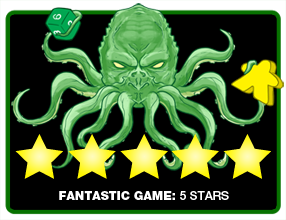 Hits:
Hits:
• So easy to teach, and fits in well with just about any gaming group
• Variety, variety, variety. Did I mention that there’s a lot of variety in this game?
• Artwork and components are all top notch.
Misses:
• A little too hectic with 5 players.






















Great review! I’m recording a rules overview tonight, so this definitely helped organize my thoughts. I see you’ve played Concordia at least once… there was a lot of surprise that Istanbul not Concordia won the Kenner… any thoughts? I give the edge slightly to Istanbul, but just barely. We’re going to play it with 5 on Wednesday, interested to see if it is hectic like you say. Great job!
That’s a tough call. I like both Concordia and Istanbul very much, although I’ve played Istanbul more times. It’s definitely the easier of the two to teach, but that sort of goes against the theory behind the Kennerspiel award. Concordia probably fits the “Connoisseur Game” a little better, but I’m still glad Istanbul won.
Just curious, where did you purchase your copy of Istanbul?
I got mine at my local game store on release day. It should be readily available just about anywhere online as well.
I’ve played this a couple of times, and have enjoyed it very much — the only thing I’ve found less than satisfying is the movement/use of the “family member” token. In addition to it just being a weird piece thematically (you release them from jail? And then send them anywhere on the board? And then other players can send them back, for no apparent violation?), it just seems a little… bland. You don’t get any *extra* action for letting them out, you just get an action at a possibly remote space; as far as I can tell from the stated rules, you still need to pick up or leave an assistant on the jail square in order to release the family member; and once they’ve performed that action, they just sit there uselessly until someone else picks them up (which, if no-one does for a while, means you have a useless assistant sitting on the jail square).
I’ve wondered about modifying the function of the family member, so that if you perform an action on the same square as your own family member, you can send them somewhere to perform an additional action. This would make the family member much more interesting/critical (and further insentivise other players to send them back to jail). What do you think?